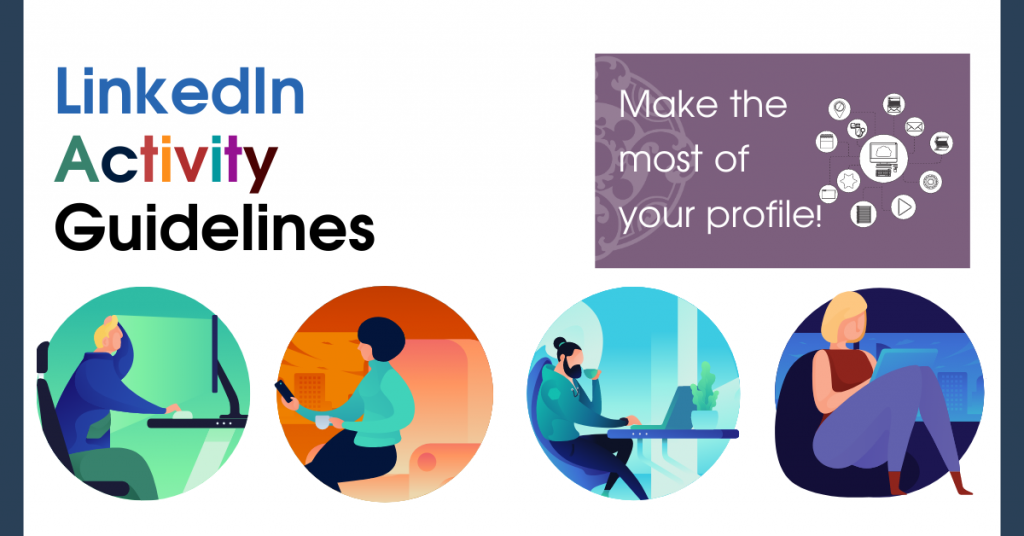
According to Hootsuite, LinkedIn has 675 million monthly users. 80% of LinkedIn users “drive business decisions”. 30 million companies are on LinkedIn and a single ad can reach 12% of the world’s population*. These are only a few of many statistical numbers that show what a powerful tool LinkedIn has become.
And yet, there are still many professionals (incl. managers & executives) who need not only help in creating, but also managing their LinkedIn profiles. And the word “managing” refers to “actively using” to support one’s professional goal.
There are four main steps to follow.
Step 1: Define your goal and call to action
Before you even begin to think about what to put on your profile, you need to plan it well and ask yourself the following questions:
- What is the purpose of your LinkedIn profile?
- Who should find it attractive / interesting?
- What action do you want them to take once they’ve read it?
- What language is important to your target group? English or local?
Let’s have a look at some examples.
Person A = Job Seeker
Goal: find a new job (important: well-defined function & industry)
Target group: recruiters, headhunters
Desired call to action: have them ask for CV (maybe even interviews)
Person B = Looking for Clients
Goal: find new clients (important: well-defined target group)
Target group: depending on the industry
Desired call to action: have them request offers
Person C = Expert
Goal: position themselves as an expert (important: well-defined field)
Target group: anyone interested in their field of expertise
Desired call to action: get requests for articles, comments, speaking engagements
Only after you have answered the fundamental questions, it’s time to prepare your profile.
Step 2: Prepare a flawless profile
Here are some materials to help you (read & apply all of them):
- LinkedIn for Job Seekers: how do you use LinkedIn when looking for a job? Or, what better ways exist than using the tag line by publishing anything from “I’m looking for a job” to “open to new opportunities”?
- How recruiters use LinkedIn: how to make your perfectly composed profile findable for recruiters?
- Creating a Perfect LinkedIn Profile: tips and know-how on creating a well-thought through, professional profile
Step 3: Prepare & execute an activity strategy
1. Choose min. 10 companies that fit your strategy and produce good content relatively regularly, e.g. 10 companies that:
- you would like to work for
- will help you position yourself as an expert
- you would like to partner with
- are market leaders and produce valuable content
- …
2. Follow those companies.
Tip: choose the most relevant decision makers within those companies and follow them too.
3. Choose 1–2 pieces of content per week to share (with a break of 1-2 days) with a meaningful comment tagging the company and – if possible – the author. Sometimes the content is not shared by the companies via LinkedIn, but on their websites. Use that too!
Important: do NOT share content more than once a day.
If you are super busy: use Hootsuite, Buffer, Edgar or other free social media automation tools, so you can prepare the content in advance – though do double–check if everything was posted properly!
4. React to comments your shares receive
Tip: thank people personally via message for sharing your content.
- Other important tips:
double-check that you are tagging (with an @) the right people & the right company. If you are not connected to them, use the tagging as a pretext for a contact request saying, “Dear XXX, I hope you don’t mind I’ve tagged you in my most recent post + link”. Why? The LinkedIn algorithm might pick up that you are tagging too many people you are not linked to and might interpret that as SPAM - add appropriate hashtags
- choose & quote fragments of the shared content to get your audience interested in reading it & to show that you yourself have read it
- you can use all 1300 characters to comment on the content – it’s usually best to keep it to 1 or 2 short(er) paragraphs
Even more tips:
- when commenting (both below a post & when sharing content) use the following assessment:
- is it valuable? → publish the comment
- is it too controversial / inappropriate → don’t publish
- does it fit the strategy? → publish the comment
- is it interesting, but outside your strategy / goal? → don’t publish
- is it a “thank you” or “congratulations”? → send it in a personal message instead
- proofread the comment prior to posting, especially the longer ones
- if you are working on an expert branding → write an article on LinkedIn publishing
Step 4: Prior to starting
1. Commit to a minimum of 90 days
2. Choose 1 or 2 days for posting & stick to it
3. Prepare a table with:
- # of contacts
- # of followers
- # of calls to action in the last 90 days
- average # of posts per month
- average # of articles per month
and fill it in on Day 1 and Day 90.
After three months you should see measurable results. If you don’t, review your profile and whether what you are publishing is attractive to your target group.
You can download the full guide with the above mentioned table here.
If you are an experienced manager with at least 10 years of experience who needs an objective review of their LinkedIn profile, click here to request it for free. Should you want to discuss your strategy during a complimentary conversation, click here or send an email to Bichl.Sandra (at) CareerAngels.eu. Subject: LinkedIn.



